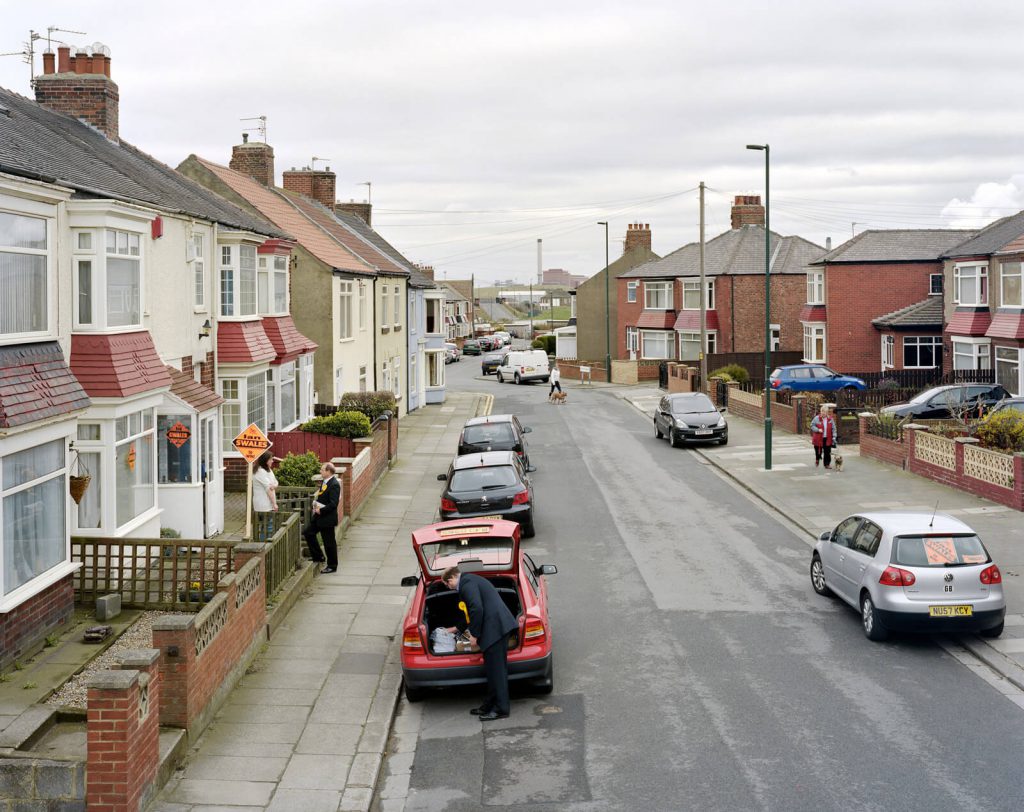
Landscape photographer Simon Roberts toured the UK in 2010 at the time of the general election, setting his large-format camera on the top of his motorhome at the various stops he made. He looks (and we look) from a position unusually high up, two or three times taller than normal adult height, gazing down and out into the middle distance. His figures are small, brief marks on a landscape: there’s an artistic reference to Bruegel’s scenes of skaters, fairs, children’s games and peasant weddings. In Roberts’s work, like Bruegel’s, landscape and marks become equally interesting, made meaningful in relation to each other.
Roberts… shows people spread about, in their own spaces and groupings… I don’t see everything together, a cosmos, but I see enough to remind me of the world at large made up of all its disparate pieces: people who are curious, disinterested, uninterested, distracted, unsighted.
Ian Jeffrey, ‘In response to the election project’, 2010
In the course of the campaign, the relationship between constituent and candidate is variously expressed in spatial terms. The doorstep encounter takes place in a liminal space between public and private, between the party worker, who may even be the candidate, and the constituent or prospective voter. The party worker is identified by a badge or rosette in party colours, and the clutch of leaflets in his or her hand. The constituent is both less and more closely defined, sought out for being simply an adult resident in a defined community but otherwise legible in all the codes of dwelling type, car ownership, age, dress and a briefly glimpsed domestic interior.
It is an encounter, an interaction between people prompted by their meeting. It may be fleeting, an opening refused or rejected, politely or not, by whoever opens the door. The leaflet serves as a way of initiating and sometimes avoiding talking, both a way of negotiating an opening and of allowing it to be refused, avoiding embarrassment. Any resulting conversation consists in exchanging accounts of the way the world is and why, and the way it might be. Its progress is uncertain, negotiated according to the rules of informal talk, including turn-taking and the use of an appropriate vocabulary or register. It is further imbued with assumptions and preconceptions, routines and rituals of political debate; it may be laden with anger, frustration, mistrust, excitement or anticipation.
Few experienced campaigners will expect to engage anyone in lengthy debate on the doorstep, fewer still to persuade them of views they don’t already hold. They might impress the undecided one way or another, or encourage some to vote who might otherwise stay at home. Canvassing is about ‘getting out the vote’, about mobilising latent support, about getting private inclination to register in public. In this way it is a sort of affirmation, making real and immediate some common cause which is otherwise only vaguely and indirectly discernible.
Candidates and their teams are drawn to the high street, because that’s where numbers of people are: much campaigning takes place in shopping centres and precincts, malls and supermarket car parks. Groups form, or are formed by supporters with placards and rosettes, banners and balloons. The crowd seems to obstruct and replace the ordinary commercial activity of the street, unless this is really an older form of market activity, that of the hawker performing in order to persuade, gathering a crowd to hear his pitch. Supporters’ colours pick up those of the advertising signs around them; balloons give the effect of a carnival parade. The candidate is not only the trader, but also the goods on display.
For the rest the canvasser, whether candidate or volunteer, spends much of his or her time between places, on pavements and grass verges, on bits of tarmac that are neither really pavement nor road, in the nondescript intermediate spaces of suburban settlement. Roberts’s protagonists look out of place, finding themselves in spaces they wouldn’t otherwise enter, in streets they wouldn’t otherwise walk down, endlessly crossing and recrossing the space between candidate and constituent.